
Embedding Word documents in Excel spreadsheets lets you consolidate information from various sources into a single, comprehensive document.
There are 3 ways to embed a Word document in Excel:
This article shows you how to implement these three techniques. You will learn the benefits and limitations of each method, and which approach best suits your needs.

Let’s get started!
Table of Contents
When you insert a Microsoft Word document as an object, you’re embedding the entire Word file into the Excel workbook.
This means that the Word document becomes a part of the Excel file, and you can view or edit the Word document directly from Excel. The result looks like this:
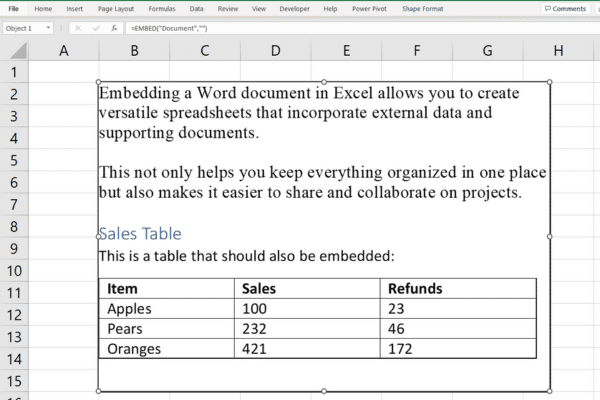
It’s important to understand that:
If your files start to get too large, there are several methods to reduce the size of an Excel file.
To insert a Word document it as an object:
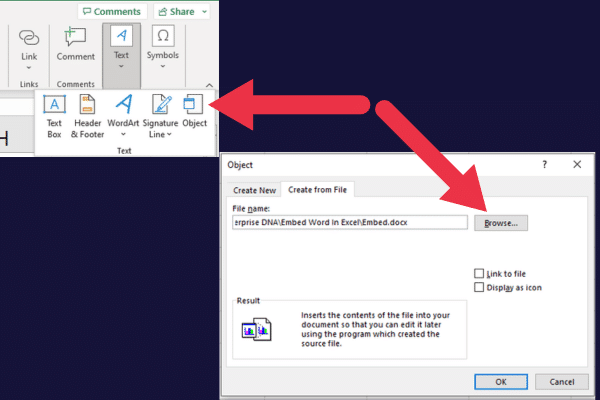
You can double-click the embedded object (or the icon, if you chose to display one) to open and edit the Word content in a separate window.
There is an option on the “Create from File” tab that controls how the embedded Word document is displayed in your spreadsheet.
When you don’t check the “display as icon” checkbox (it’s off by default), the contents of the first page will be displayed.
When you check the “display as icon” checkbox, the spreadsheet will show an icon that indicates there is an inserted Word document.
This picture shows an example:
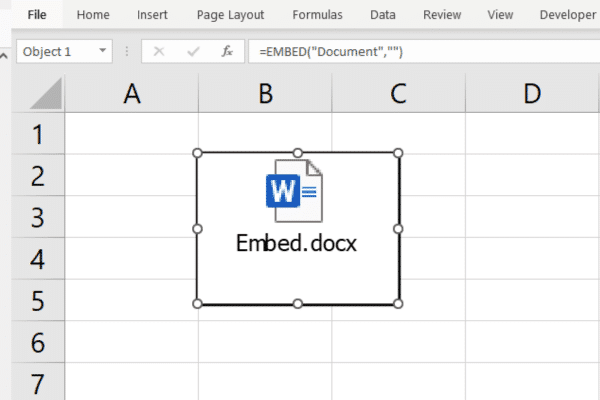
Embedding a Word document in Excel using insertion is a straightforward process, but as you’ll see in the next section, you also have another option — linking.
When you create a link to a Word document, you’re establishing a connection between the workbook and the external Word document. The link allows you to open the Word document by clicking on the hyperlink in Excel.
There are important differences in the outcome of this method and inserting the document as an object:
Keep these limitations in mind when you’re sharing your Excel file on SharePoint or other shared storage.
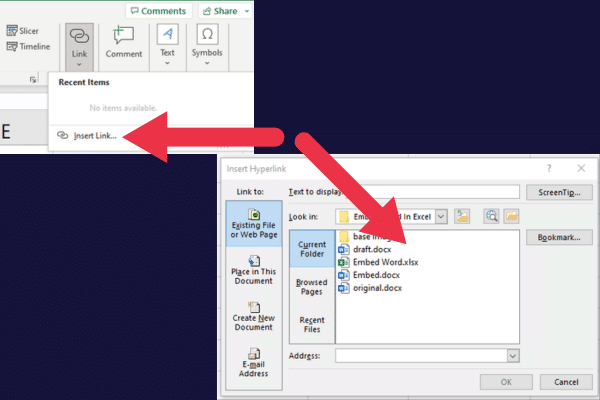
When you click on the linked Word document, the document opens in Microsoft Word.
Embedding a Word document into Excel via linking is good enough for most cases, but you also have the option to copy and paste the contents of your Word document, which is what we’re covering next!
If you’re looking for a quick alternative method, you can simply copy and paste the contents of a Word document into your Excel spreadsheet.
This works well with plain text or a simple word table.
The main drawback is that you don’t retain the formatting and advanced features of the Word document. The other methods in this article are more suitable for retaining Word features.

To Copy and Paste from Word to Excel:
This picture shows an example of the results. Note that the format of the H2 heading in Word has not been retained in the Excel spreadsheet. However, the table displays well as Excel data.
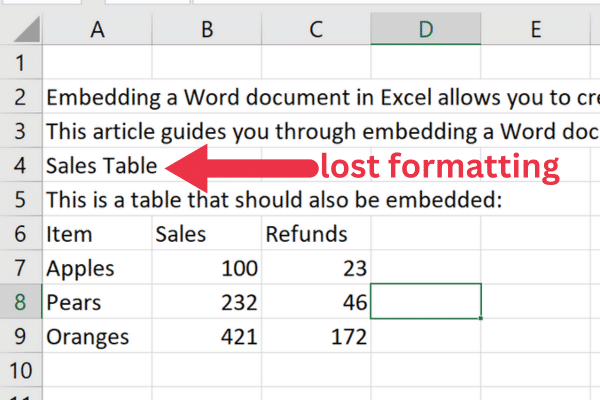
Copying and pasting data is one of the fundamental tasks in Excel. Check out our introduction to Microsoft Excel for other fundamental operations.
Next, we cover how you can work with embedded documents, how you can embed multiple documents, and how to embed a document in multiple cells in the coming sections. Let’s go!
An advantage of embedding a document as an object is that you can resize or move it to have a clearer display in your spreadsheet.
How to Resize the Embedded Object
To resize an embedded Word document in Excel, follow these steps:
You can resize the object proportionally by holding the Shift key while dragging the corner handles.
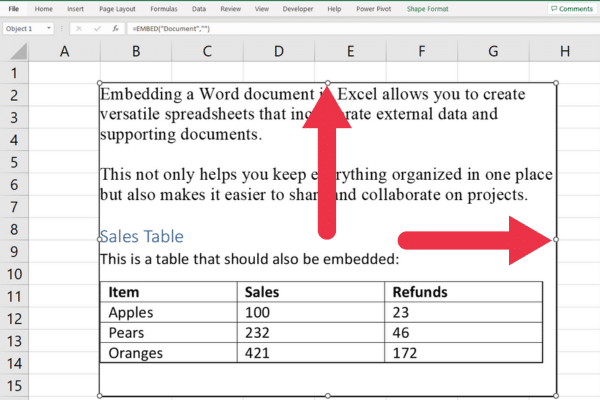
How to Move the Embedded Object
To move an embedded Word document in Excel, open Excel and follow these steps:
When working with multiple Word documents, it’s possible to embed them all into a single Excel worksheet. To do this, simply open Excel and follow the standard embedding process for each file:
Here is an example of two embedded documents (displayed as icons):

Keep these considerations in mind for embedding multiple documents:
There are times when you may need to embed a Word document into multiple cells within an Excel sheet. This can provide a better structure for your information, which makes it more accessible and easier to understand for your audience.
There are two methods to achieve this:
To use this method before insertion, follow these steps:
To use this method after insertion, follow these steps:
Remember to maintain a consistent format and style throughout the sheet for a cohesive and professional appearance.
Now that we’ve looked at the ways to embed documents in different scenarios in Excel, let’s talk about how object linking and embedding works in the next section!

Object Linking and Embedding (OLE) is a technology used in Microsoft Office applications, which allows you to insert content from one program into another by creating a dynamic link between the two.

It is the underlying technology that enables the embedding of a Word document into Excel. OLE allows the Word document to maintain its functionality within Excel, enabling you to view or edit the document directly from the Excel workbook.
There are four technical components of the technology:
Embedding a Word document into Excel allows you to consolidate information, streamline collaboration, and enhance productivity.
You learned three methods in this article and should now understand which technique suits your requirements. By leveraging the combined power of Word and Excel, you will create more organized, accessible, and professional documents.
It’s all about finding the method that suits you and your needs. So go on, grab that Word doc and give your Excel spreadsheet a bit of a textual twist. And remember, don’t be afraid to experiment. Excel’s cooler than you think. Happy embedding!

This guide will help you learn how to use the SUMPRODUCT function in Excel for calculating weighted averages, with practical examples and clear instructions.

Unlock the full potential of Excel with this comprehensive guide to mastering shortcuts. Improve your productivity and streamline your workflow with key combinations.

Learn how to use VBA in Excel to efficiently manage transportation data.

A project focused on implementing an extensive VBA-based inventory management system within an Excel spreadsheet to streamline data handling.

This project aims to streamline and boost efficiency in Excel spreadsheet tasks using VBA arrays.

Learn to analyze and summarize complex data using Excel’s powerful Pivot Table feature.

This project teaches how to manage and automate financial data in Excel using VBA programming.

Hey there, fellow Mac users! Have you ever wondered how you can level up your data management game with.

As a data analyst or a spreadsheet enthusiast, you’re probably familiar with the many ways Excel can.

One of the best things about Excel is how quickly and easily it can add up all the numbers in a column.

In data analysis, interpolation plays a crucial role in estimating values that fall between known data.

So you're looking to learn Excel, one of the most widely used software applications in the.